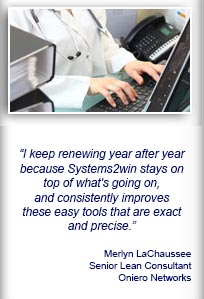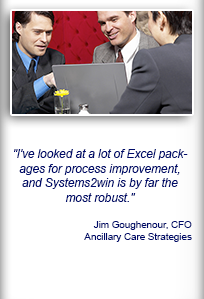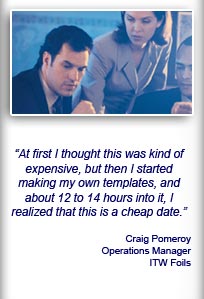Installation and Setup
Installation - Each User. Installation - Multi-user. Language Translations. Personalize Your Templates.Systems2win Training.
Quick Start Initial Training. New User Training. Training Matrix. Systems2win Leadership. Training Classes.Lean Training
Lean Training and Coaching. Lean Principles. Muda 8 Wastes. Goal - Lean Flow. Roadmap - Lean Journey. Value Stream Mapping. Standard Work. Hansei Lean Thinking. Lean Dictionary. Online Lean Training. Lean Leadership.Microsoft Office Training
Excel Training. Excel Drawings (without Visio). Excel Charts. Word Training. PDF Training. Document Storage and Naming.Support
Support.Balanced Scorecard template
Balanced Scorecard software with all the power and familiarity of Microsoft Excel
Measure what matters most
Your strategic planning team uses a Balanced Scorecard to define a set of measures that provide a balanced overall view of the performance of an organization and sub-teams within it.
This simple Excel template comes with:

- A 4-page 'idea generators' handout jammed with ideas for how to choose Balanced Scorecard metrics.
And answers the question: "What measures have other companies used?"
- More than a dozen surprisingly powerful templates to help your executives better prepare for your next strategic planning session.
- A Policy Deployment Matrix to more effectively implement your strategic initiatives

Sample Balanced Scorecard Example
Balanced Scorecard Terminology
Column Headings
Here are the (pop-up help) explanations for each of the headers on your Balanced Scorecard template.
Objectives — What are we trying to accomplish?
Measures — How will we measure our success?
Targets — What are our goals? (Using our chosen measures)
Action Programs — (optional)
If there are any action programs directly impacting this objective, they can be listed here.

There is not a one-to-one correlation between Objectives and Action Programs.
Some Objectives might not have any Action Programs, while others might have several.
A single Action Program might directly impact several Objectives.
A very clear way to correlate Objectives, Measures, Targets, and Action Programs is by using your Policy Deployment Matrix template. (XMatrix.xlsx)
Recipients — Who should receive this communication?
Means of Communication — How will we communicate the results of what we are measuring?
Examples: Perhaps post printed Measures Scorecards in public places, email list, newsletter, web site…
Be sure to define the frequency of updates.
Responsible Team Member — The person responsible for publishing the communication
Accountable Executive — The Executive accountable for monitoring and ensuring performance
Results Status — How are we doing?
Tip: You might want to hide the 'Results Status' column when you publish your printed scorecard, and only use it in your online version.
Or you might move the column, so that results are right next to the measures and targets.
Section Headings
In Robert Kaplan's classic book, 'The Balanced Scorecard', he suggests organizing your strategic objectives into the following 4 categories:
- Financial perspective
- Customer's perspective
- Internal Business Process perspective
- Organizational Learning & Growth perspective
Since there is so much overlap between the Customer's perspective and the Internal processes needed to support those customer needs, some strategic planning teams have found it less confusing and more concise to combine these into a single heading area:
Customer and Internal Business Processes Perspective.
Of course, your team can agree to use any section headings you want.
How to use your
Balanced Scorecard template
Find and open your template
Find and open your Balanced Scorecard Excel template
(BalancedScore.xlsx)
in the same way that you find and open your other 150+ Systems2win templates.

Save your working document
following the usual document storage and naming conventions established by your leaders
Open a Blank Sheet
When you're ready to start doing your own real work...
click the button to 'Open a Blank Sheet'
Excel Ribbon > Systems2win tab > Open a Blank Sheet
This blank sheet is where you will do your real work
(not on the Sample sheet — which gives you sample data that is extremely helpful for learning how to use your new tool, but is the wrong place to do your real work)

Rename your new sheet.
If English is not your preferred language
Switch to your language, just like every Systems2win Excel template.
Now your team is ready to start using your
Balanced Scorecard Excel template
Strategic Planning at the highest level
Step 1) Ensure that each participant comes well prepared
Distribute your Systems2win Strategic Planning Worksheets
to the highest-level person responsible for each area of responsibility with instructions to bring their filled-in worksheets to the strategic planning session(s) to serve as well-considered and well-documented starting points for discussion (and revision & improvement) of strategies that require the understanding and support of inter-related departments and functional areas of responsibility.
Step 2) Go through your agreed-upon strategic planning process
Ideally, your team will continuously experiment with and continuously improve your approaches to strategic planning.
With each strategic planning cycle,
encourage your people to return (again and again)
to the Hansei questions to stimulate Lean Thinking.

Step 3) Agree upon a set of Balanced Strategic Measures
There should usually be only 1-7 Strategic Objectives per Section heading, with 1-3 Measures each.
Follow the link in your Balanced Scorecard template to open the PDF that gives your team a long list of idea starters for different types of measures that other teams have found useful for each of the Balanced Scorecard section headings.
The process is as important as the results
The way your team goes about working together is as important as your strategic planning deliverables
Pay attention to the ways that your people work together to come to agreements for how to:
- Brainstorm many possible ideas
- Clarify, consolidate, and improve upon ideas
- Narrow your alternatives
- Come to final decisions
for the few strategic objectives that you all agree to commit to accomplish
When your decisions have been made, document your team's decisions using your Balanced Scorecard template.
Step 4) Create your highest-level Hoshin Plan
To further clarify and communicate responsibilities for implementation of agreed-upon strategic initiatives, create your top-level Hoshin Plan Policy Deployment Matrix.
Step 5) Publish your results
Publish your strategic planning deliverables where they can be found and referenced by all stakeholders.
Your strategic planning deliverables usually consist of...
- Your Hoshin Plan X Matrix
created using your XMatrix.xlsx template
- Your Strategic Plan
created using your StrategicPlan.docx template
- Your Balanced Scorecard
created using your BalancedScore.xlsx template
Note: Because your X Matrix Hoshin Plan contains the most important elements of your Balanced Scorecard, it is not uncommon to publish, promote, and reference that one simpler document.
Departmental Scorecards
Once your highest-level executives have completed your top-level Hoshin Plan,
then (if your organization is large enough to justify it), each Department will create their own Departmental Scorecards
(following a process very similar to the Strategic Scorecard instructions - but at a departmental level)
Each Department should maintain its own Balanced Measures Scorecard and/or X Matrix,
defining its own Departmental Objectives & Measures designed to support the company-wide Strategic Objectives & Measures
Start with the Strategic objectives and initiatives for which your department is (at least partially) responsible.
Then go through an agreed-upon catchball process
for the leaders of your department or functional area of responsibility to come up with an approved Policy Deployment Matrix (and perhaps Balanced Scorecard) for your team
Then publish and display your Departmental X Matrix where your team members will actually look at it often
thereby accomplishing the primary objectives of a Balanced Measures Scorecard...
to keep strategic goals visible and 'always in mind' as everyone goes about their daily tasks, knowing very clearly how their work inter-relates with the shared strategic mission that everyone else is also working together to accomplish

Also see the online training for how to manage to a Strategic Challenge

You get this Balanced Scorecard Excel template when you purchase any of the other Systems2win templates
Own them ALL for one low price!
New User Training
Your Systems2win templates come with free New User Training
to quickly learn features that are common to all 150+ templates

Training to get you started.
Tools you won't outgrow.
Training and Coaching
Consider Training and Coaching to support your teams to succeed

Why re-invent?
Schedule a Conference
Schedule a conference
to discuss your challenges
with an experienced lean advisor
Download Trial Now
Get a dozen trial templates,
and another dozen free gifts
@@@ Better conversion rate
if call to action is for a specific tool, and shows the image

Try It
Try this template
along with a couple dozen more
process improvement tools
Calls to Action Botttom
Related Topics
Related Topics section WITHOUT TESTIMONIALS
Replace this paragraph with menu library item for topics related to this video
Training and Coaching
Consider Training and Coaching to support your teams to succeed

Training to get you started.
Tools you won't outgrow.
Schedule a Conference
Schedule a conference
to discuss your challenges
with an experienced lean advisor






















